
Day 6
Our day in Punakha was pretty relaxed.
We'd been setting an ambitious pace, both physically and
informationally, so this was a welcome change. Again, Tashi's
experience benefitted us, and Susan and I probably would have just
“pushed through it” and enjoyed ourselves less by doing more.
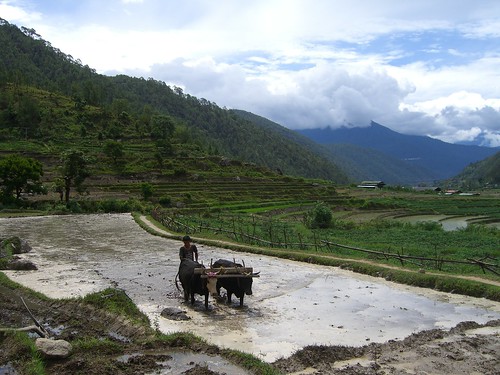
We did take a short hike up (which
still left us gasping) to a temple, but one very different again from
those we had seen before. This one was shaped like a giant Stupa,
and had several levels.
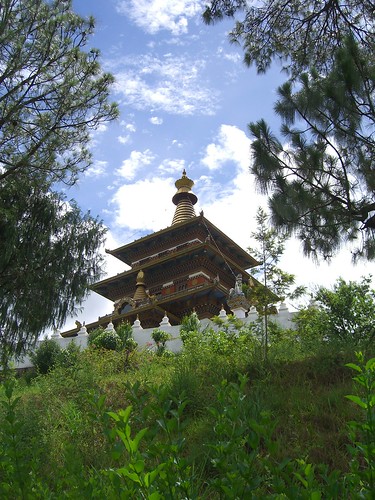
When we got there, after a short but steep
climb that skirted some rice fields, we met an old woman from the
local farms.
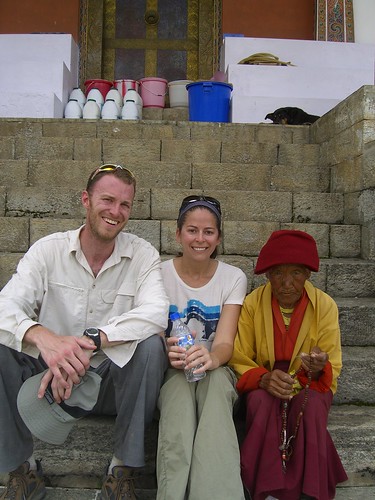
Too old and vision impaired to work anymore, everyday
she climbs the mountain to walk circles around the temple and pray.
She was 80-something, which is really, really ancient when you have
spent 70-something of those years toiling in rice fields.
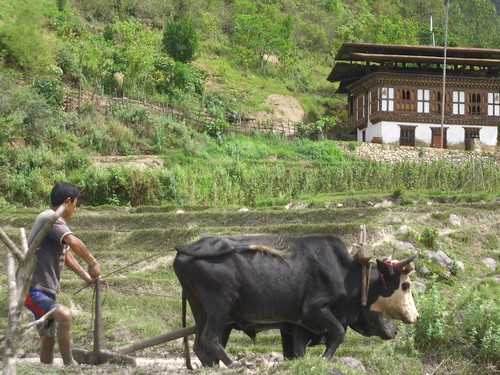
The families bond together to work
their fields. Everyone has “their plot” but will cooperate to
plant and harvest and execute the various tasks of cultivation. From
our high point we counted just under 40 people working a set of
paddies that terraced an area about a square kilometer – plowing,
tilling, planting (at this time of year).
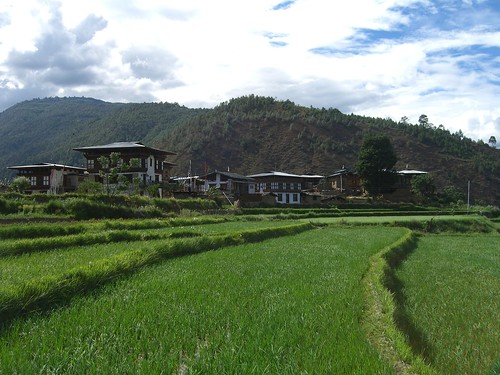
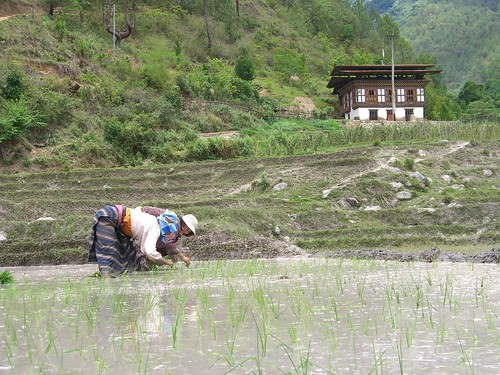
Atop the stupa/temple we were treated
to great views.
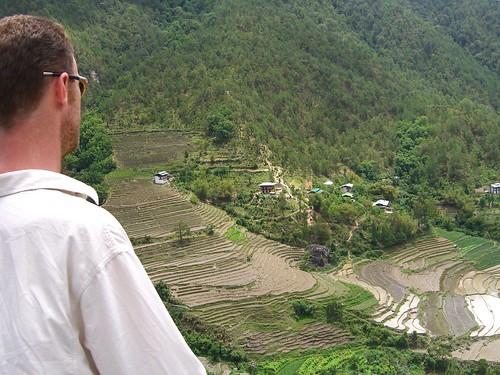
We were soaking up the whole thing; our second to
last real day in Bhutan, the view of the Himalayan “foothills”,
the bright blue sky, the green trees and brown rice paddies, standing
atop a great religious site in the heart of the nation that invented
the idea of “Gross National Happiness” when the monk's cell phone
rang. An hour ago we were taking photos of a young man as he
adjusted the yoke on his oxen; knee deep in the rice paddy. Ten
seconds earlier the red-robed monk was answering our questions in the
near-whisper of a tenant of holy places. Now he was yammering into
his mobile at a cellphone-voice-volume that would make a New Yorker
proud.
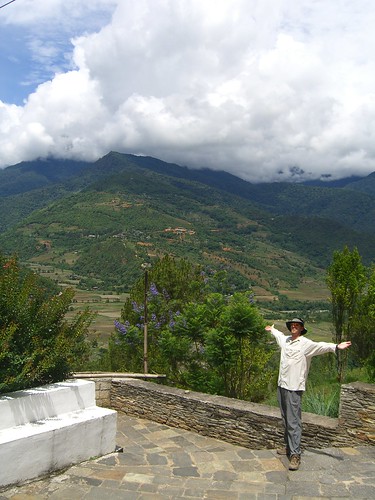
For lunch we picnicked along a river.
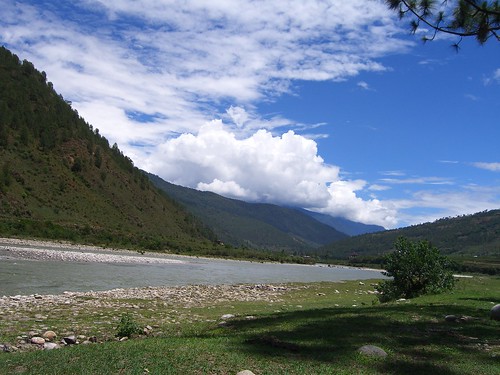
As we pulled up a couple of local girls were bathing. The guys
teased and flirted as the girls laconically covered up and gathered
their things to go home. We had a leisurely feast, lounging on rugs
set upon the grass then sort of lounged by the water.

Tashi and
Phubu wandered in search of rocks to play quoits. A couple of hours
later we packed up, and the guys did their best to spy on the girl
who was bathing but had strategically parked her car in their line of
sight. Nudity doesn't have the taboo here that it does at home, but
a naked pretty girl is still a naked pretty girl.
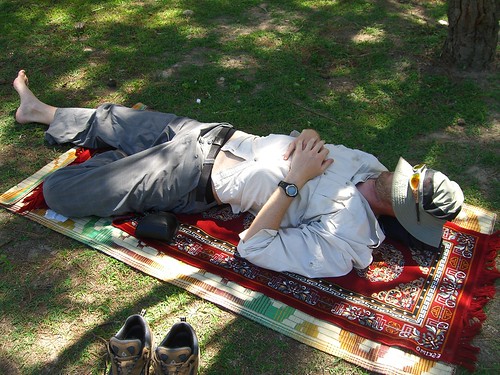
Last stop for the day was the big Dzong
of this area. Once upon a time this was the capital, and it is still
the winter home of the Monks who reside in summer at the main Dzong
in Thimphu. To Tashi, this is the most beautiful of all the Dzong,
and he is deliberate in saving it for the climax of our trip. It had
also undergone a major renovation recently, a result of fire damage.

Having now seen
the Art School we had a new appreciation for the detail work of these
places, and this was the most ornately decorated of all. The main
temple was a huge, four story chamber. The columns were clad in
decorated bronze work, the walls lined with Buddas and lotus-seated
scultures of deceased masters, every surface and aquare-inch of
ceiling was painted with detail work. The Budda itself and the
attendant Bosshisatvas, Precious Master, and Tibetan King were
equally impressive in scale and artistry.
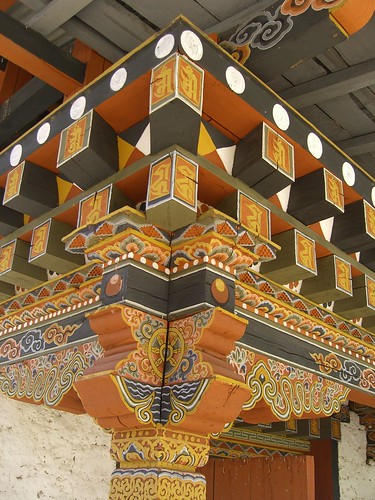
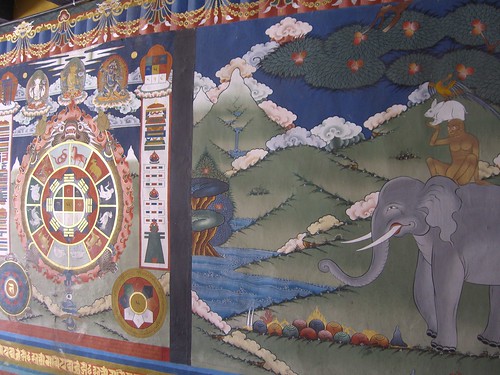
There was
another group touring the Dzong as well, a bunch of Dutchmen (you see
them everywhere). It was led by a friend of Tashi's, who it was
later explained was a former governor of the region. He was still
entitled to a special colored sash, but could no longer wear the
ceremonial sword of office.

By chance we
were there at the same time as a former High Lama of Bhutan, with
whom we shook hands (Tashi got a blessing). We introduced ourselves
and he asked where we were from. “Enjoy your stay”. Nice guy.
In his entourage were the three folks from Taiwan we met at Jack and
Kharma's. This really is a small country.
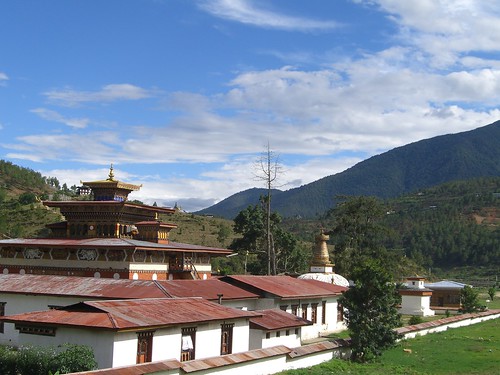
Back in Punakha
town itself we briefly stuck our heads in at another temple. The
monks were performing a ritual, but were shortly quiet again. One of
them seemed uncertain about his duties, and an older monk was
instructing him on the specifics of placing the offering before the
altar. A young monk was then running around filling cups from which
they all drank. “A holy water ceremony?” “No, afternoon tea”,
explained Tashi. We got the requisite “look at the giant” smiles
as we slipped back out. The grounds of the temple also held a
Nepalese stule stupa, and we got a primer on the stylistic
differences of the Nepalese, Tibetan, and Bhutanese stupas, all of
which can be found in Bhutan.